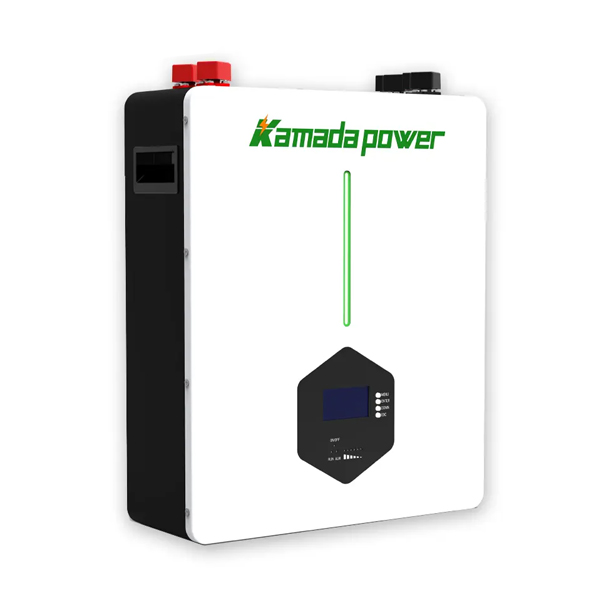はじめに
よりスマートなチャージ・コントローラーを使うだけで、太陽光発電の出力が20%も向上するのを初めて見たとき、MPPTが単なる流行語ではないことを実感した。その日はシエラネバダ州の肌寒い朝で、雲は山頂に散らばり、太陽光はかろうじて差し込んでいた。その瞬間、私のソーラー技術に対する見方が変わった。
しかし、MPPTは常に最良の選択なのだろうか。率直に言って、私はMPPTが常に正しい答えとは限らないと考えている。最大電力点追従が実際にどのように機能するのか、そしてどのような場合に最も重要なのかを説明しよう。

鎌田パワー 10kWhパワーウォール・ホームバッテリー
MPPTとは?(最大電力点追従)
MPPTとは何か?
MPPTとは 最大電力点追跡.これは、太陽光発電システムが、太陽熱を利用するための技術である。 最大出力 MPPTは、ソーラー・パネルの出力を最適な状態に保つよう、電圧と電流を動的に調整します。ソーラーパネルの出力は日照、温度、電気負荷に左右されるため、MPPTは電圧と電流を動的に調整し、最適な性能ポイントにとどまるようにする。
ラジオを最もクリアな音にするために正確な周波数にチューニングするようなもので、エネルギー生産が最も高くなる「スイートスポット」に当たるようにソーラーシステムをチューニングする。
とはいえ、以前はMPPTの方が万能だと思っていました。しかし、砂漠の条件下で何十ものオフグリッドシステムに携わってきた結果、MPPTではほとんど歯が立たないようなシナリオを見てきました。
わかりやすいMPPT
自転車で上り坂を走ることを想像してみてほしい。効率よくスピードを維持するためにギアを変速します。MPPTはこれと同じように機能します。太陽光や気温が変化しても、ソーラーパネルの電気的な「ギア」を調整してピーク・エネルギーを供給します。
興味深いことに、同じ原理が初期の水力発電タービンにも使われていた。ソーラー発電はそのプロセスを自動化しただけなのだ。
MPPTの仕組み電圧、電流、電力曲線
ソーラーパネルはパワーカーブ(電圧と電流によって出力がどのように変化するかを示すグラフ)に従っています。MPPTアルゴリズムはこの曲線を常に分析し、最も高いワット数(電圧×電流)を生み出すポイントをゼロにする。
例えば、200Wのパネルでは、一日を通して電圧と電流が変化することがあります。MPPTは、コントローラーが1時間ごとにパネルの最も効率的なポイントで動作するようにします。
業界は認めようとしないが、すべてのMPPTアルゴリズムが同じというわけではない。一部の安価なユニットは、雲の動きが速いときに的外れな、古くて遅いトラッキング方法を使用しています。私は、部分的な日陰に適応できないブランドユニットに何千ドルも投資したクライアントを持ったことがある。
MPPTが現れる場所
MPPTは、太陽光発電システムで広く使われている:
- オフグリッドソーラーチャージコントローラ バッテリー充電用
- ハイブリッド・インバータ 系統電力とバックアップ・ストレージを管理する
- EVソーラー充電システムエネルギーの最適化が鍵となる
どこにでもあるものだが べきである というのは別の質問だ。
太陽エネルギーシステムにおけるMPPTの役割
エネルギーハーベストの最大化
MPPTは、それぞれの植物に必要な水の量を把握している賢い庭師のように機能します。電圧と電流をリアルタイムで微調整することで、太陽光が弱い場合や変動する場合でも、パネルが常に最適な範囲で動作するようにします。
より多くのエネルギーを取り込むということは、より速いバッテリー充電、より高い自給率、より低い電気代を意味する。
しかし、ここからが回り道だ:中世の農民たちが、季節ごとの川の流れに基づいて灌漑用水路を調整していたことを思い浮かべてほしい。彼らはMPPTが存在するずっと前から、タイミング、日陰、水量を把握していたのだ。我々は自動化に追いついただけなのだ。
バッテリー充電効率の向上
バッテリーは、電圧と電流が正確に管理されているときに最もよく充電されます。MPPTは、ソーラーパネルの出力をバッテリーの充電ニーズに合わせることで、これを実現します。余分な電圧を無駄にすることなく、有用な電流に変換し、充電のスピードアップとバッテリー寿命の維持を実現します。
コップに効率よく水を入れ、一滴もこぼさず、早く満タンにするようなものだ。
私は、MPPTベースのシステムを改造したヨットを担当したことがある。アップグレード前は、フル充電に8時間の太陽光が必要でした。MPPTを導入した後は、5時間で充電できるようになった。このアップグレードだけで、長い航海の数週間を節約できた。
天候と環境の変化への適応
太陽光は予測できない。雲、日陰、気温の変化が出力に影響します。MPPTコントローラーはこれらの変化を追跡し、それに応じて調整します。
従来のコントローラーが停止した霧の日でも、MPPTユニットがバッテリーを充電し続けたのを見たことがある。ポートランドで行われた太陽光発電のイベントでは、突然の暴風雨の中、MPPTが照明システムを文字通り救ったこともありました。
オフグリッドと系統連系MPPTの比較
- オフグリッドシステム 送電網に接続されていない場合は、MPPTに頼って太陽から可能な限りのワットを得ることが重要だ。
- グリッド・タイド・システム MPPTを使用することで、系統電力への依存を減らし、コスト削減を最大化する。
どちらのセットアップでも、MPPTは物事を円滑に進める静かな働き者です。MPPTはピークを見つけようとしてエネルギーを浪費することがあり、特にパネルストリングが不一致の場合はそうです。
MPPTとPWMの違いとは?
技術比較
PWM(パルス幅変調)コントローラーは、よりシンプルで安価だ。ソーラーパネルを直接バッテリーに接続し、バッテリーレベルに合わせて電圧をトリミングする。しかし、多くのエネルギーをテーブルの上に残すことになる。
MPPTは、電圧と電流を独立して調整するスマートDC-DCコンバータを使用し、多くの場合、システム効率を10-30%向上させる。
- MPPTの効率: 93%-99%
- PWMの効率: 70%-90%
PWMコントローラーとメキシコの角度の良い太陽電池アレイを組み合わせたところ、春にカナダで使用した基本的なMPPTシステムにほぼ匹敵する発電量が得られたことがある。場所と用途が重要なのだ。
MPPTの利点の実例
寒い冬の朝、400Wの太陽電池アレイを使ってみよう。気温が低いため)パネル電圧が高くなり、MPPTが太陽電池を引き込むチャンスとなる。 最大30%のエネルギー増加 PWMよりも。つまり、バッテリーの充電が速くなり、厳しい条件下でもパフォーマンスが向上する。
モンタナ州のあるクライアントは、MPPTに切り替えた後、冬の収穫量が2倍になったことを覚えている。皮肉な話だ。彼はセールスマンの言うことを信じなかった。
MPPTは常に価値があるのか?
MPPTコントローラーはコストが高く、PWMユニットの2~3倍の価格となることが多い。しかし、このようなシナリオでは投資対効果は明らかです:
- 大型ソーラーシステム
- 寒冷地
- 24Vまたは48Vバッテリー搭載システム
- 日陰または一部曇りの環境
小規模な12Vシステムを安定した太陽の下で稼働させるのであれば、PWMはまだ手頃な価格で仕事ができるかもしれない。私の直感では、近いうちにMPPTロジックとPWMのコスト効率を融合させたハイブリッド・コントローラーが登場すると思う。
先進のMPPTインサイト
リアルタイム環境適応
MPPTコントローラーは、ただ "セットして終わり "ではない。温度、日射角度、日陰の変化に合わせて常に調整します。状況が目まぐるしく変化しても、MPPTは高出力を維持します。
私は、MPPTユニットが影や通過する雲に瞬時に反応し、PWMでは困難な安定したエネルギーフローを維持するのを見てきた。ヨセミテ近郊のあるプロジェクトは、どんなデータシートよりも微気候が重要であることを教えてくれた。
部分的なシェーディングの処理
シェーディングは厄介で、電力曲線に複数のピークを作ります。洗練されたMPPTアルゴリズムは、偽のピークと真の最大電力点を区別することができます。
パネルが東西に設置されていたり、樹木が部分的に覆われていたりする場合、これは1日のエネルギー収量に顕著な影響を与える。
しかし、すべてのMPPTユニットがこれに対応できるわけではない。私がテストした格安モデルは、木の枝に直面すると実際に性能が低下した。
MPPTの限界
- 低照度はMPPTの効果を低下させる
- ソーラーパネルが不一致だとアルゴリズムが混乱する可能性がある
- バイパス・ダイオードは精度に影響することがある
- 日照時間の急激な変化は、より遅いアルゴリズムに挑戦するかもしれない
また、正直なところ、コントローラーの中にはうまく動作しないものもあります。ファームウェアのアップデート後にMPPTの動作が遅くなるのを見たことがあります。
未来:AI駆動MPPT
次世代のMPPTコントローラーは、変化に反応するのではなく、変化を予測するためにAIやIoTを利用するかもしれない。現場の状況を学習し、曇りの期間を予測し、それに応じて出力を最適化するシステムを想像してみてほしい。
それはSFではなく、太陽制御が向かう先なのだ。そして、そろそろ潮時なのだ。
適切なMPPTコントローラーの選択
スペックをセットアップに合わせる
マッチする主な要素
- PVアレイ電圧とコントローラ入力範囲(共通:100V、150V、250V)
- バッテリー電圧(12V、24V、48V)
- アレイ電流対コントローラ定格電流
使いもしない電圧容量にお金をかけ過ぎないことです。しかし、サイズを小さくしてシステムを制限することもありません。以前、120Vのアレイ用に250Vのコントローラーを購入したクライアントのコンサルティングをしたことがある。お金の無駄でした。
重要な機能
- 高速トラッキング
- 高効率定格
- バッテリー温度補正
- リモート・モニタリングとファームウェア・アップデート
- 安全保護(過電流、過電圧、温度)
これは個人的なヒントですが、アクティブなロギングのあるコントローラを探してください。何か問題が起きたとき、ログはあなたの強い味方です。
結論
MPPTはソーラーマジックではありません。そうしなければ失われてしまうエネルギーを回収することで、ソーラーシステムをより賢く、より効果的に働かせることができます。
大規模で複雑なセットアップには明らかに有利だが、小規模で低予算のソーラー発電所建設には必ずしも必要ではない。
ニーズを知る。環境を理解する。そして、MPPTがあなたのシステムにとって賢い選択かどうかを判断してください。
正直なところ、以前はすべてのソーラーセットアップにMPPTが必要だと思っていた。しかし、今は考えが変わりました。今は、太陽光発電を設置する場所、方法、理由次第だと考えています。
よくあるご質問
Q1: MPPTはどんなソーラーパネルでも使えますか?
A: はい、パネルの電圧と電流がコントローラーの制限内であれば大丈夫です。MPPTは特に高電圧パネルに有効です。
Q2: MPPTは小規模ソーラーシステムにとって価値がありますか?
A: 太陽光が安定しており、システムが200W以下であれば、PWMコントローラーで問題ありません。変動する条件や将来の拡張のためには、MPPTは賢いアップグレードです。
Q3:温度はMPPTの性能に影響しますか?
A: はい。MPPTはパネル電圧が高いため、寒冷地ではさらに優れた性能を発揮します。また、利得は小さくなりますが、熱にも適応します。
Q4: MPPTはどのようにシェーディングを処理するのですか?
A:先進的なMPPTコントローラーは、パネルの一部が遮光されていても、遮光を回避して真の最大電力点を見つけることができます。
Q5: MPPTコントローラーはメンテナンスが必要ですか?
A: メンテナンスはほとんど必要ありません。ファームウェアの更新とケーブルの安全性を確認するだけです。遠隔監視により、すべてをチェックすることができます。